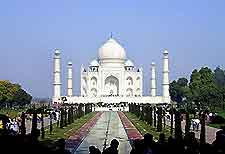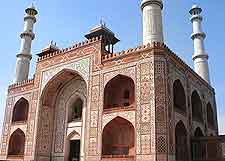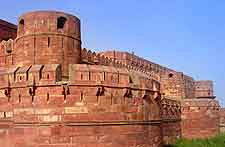Agra History Facts and Timeline
(Agra, Uttar Pradesh, India)

The history of the city of Agra, which is set in the Indian state of Uttar Pradesh, is bound up with the world's most exquisite memorial to undying love, the Taj Mahal.
The glorious white marble monument was built by Mughal emperor Shah Jahan after the death of Mumtaz Mahal, his beloved consort. The city, known for over 2,000 years by its present name, experienced its glory days between 1526 and 1658, when it held the prized position of capital of the mighty Mughal Empire.
Early Days
Agra was first mentioned in an ancient Hindu script, the Mahabharata, and was later referred to by the Roman geographer and astronomer Ptolemy, with the first written records of Agra dating from the 11th century. Prior to the 16th century, the city was held by a succession of Hindu and Muslim rulers until finally, under the rule of Sultan Sikandar Lodi of Delhi, it gained importance as the new capital of the region, replacing Delhi by the sultan's order.
By 1526, its new prominence had attracted the attention of Mughal emperor Babur, who overthrew the Delhi ruler at the first battle of Panipat and ended the Lodi Dynasty. Immediately, Agra was appointed as the capital of the Mughal Empire and the residence of its imperial dynasty, with magnificent palaces, temples, mansions, forts, glorious gardens and monuments erected over the following 120 years.

The Mughal Years
Three great Mughal emperors, Shah Akbar, Shah Jahangir and Shah Jahan, the latter the greatest of the three, reigned in Agra, which was known as Akbarabad during the Mughal period. The history of the three Agra reigns is easily traced today, due to the breathtaking buildings serving as the rulers' legacy to the world. The dynasty's founder, Babur, began the beautification of the capital with Aram Bagh, a formal Persian garden set along the river banks.
Shah Akbar commissioned the massive Red Fort, as well as many centres of learning, arts and religion, and a new city set on Agra's outskirts. Shah Jahangir, Akbar's son, created more gardens inside the vast walled Red Fort's grounds, and Shah Jahan's love of architecture and his consort produced the greatest treasure of all, the Taj Mahal, which was completed in 1653.

The 19th Century
By the beginning of the 19th century, the great empire had fallen, leaving only its architectural glories as a reminder. The British Raj took over in 1803, establishing its Presidency in 1835, just before the Great Famine struck in 1837. In 1857, two Agra regiments of the Indian Army joined the Indian Rebellion and marched to Delhi, and a mob ran riot around the city's streets. Subsequently, Agra remained in British hands until the independence of India was declared in 1947.
The 20th Century and Onwards
By the second half of the 20th century, Agra had gained fame and fortune as a world tourist destination for its history and magnificent structures, three of which - the Taj Mahal, the Red Fort and the abandoned settlement of Fatehpur Sikri - are now UNESCO listed. Nowadays, the city is a major manufacturing hub, but still depends on tourism for much of its income.
 The history of the city of Agra, which is set in the Indian state of Uttar Pradesh, is bound up with the world's most exquisite memorial to undying love, the Taj Mahal.
The history of the city of Agra, which is set in the Indian state of Uttar Pradesh, is bound up with the world's most exquisite memorial to undying love, the Taj Mahal.
